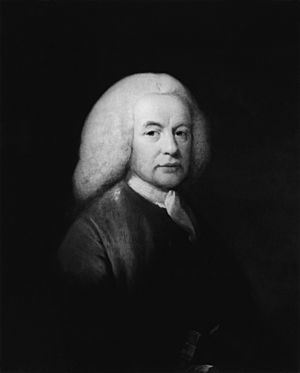James Parsons (physician) facts for kids

James Parsons (born March 1705 – died 4 April 1770) was an English physician, someone who studied old things (an antiquary), and a writer. He was also a Fellow of the Royal Society, which is a very important group for scientists.
James was born in Barnstaple, England, but grew up in Ireland. He later went to Paris to study medicine. After getting his medical degree from Rheims, he moved to London in 1736. There, he continued his studies with a famous doctor named James Douglas. In 1741, he became a member of the Royal Society.
Contents
Early Life and Medical Career
James Parsons was born in March 1705 in Barnstaple, Devon. His family moved to Dublin, Ireland, where he received his education. For a while, he worked as a tutor. Later, he decided to study medicine in Paris for several years. He earned his medical degree on 11 June 1736.
A month later, he arrived in London. He had letters of introduction to important people like Hans Sloane and Richard Mead. He also worked with Dr. James Douglas, helping him with his studies of the human body. In 1738, Parsons became a doctor at the St. Giles public infirmary. He also started working with patients who were having babies. In 1751, he was allowed to practice medicine by the Royal College of Physicians.
A Life of Learning and Friendship
For many years, James Parsons lived in Red Lion Square, London. He was friends with many important thinkers and scientists of his time. These included Martin Folkes, William Stukeley, and Matthew Maty. He was elected a Fellow of the Royal Society in 1741. Around 1750, he became an assistant foreign secretary for the society. This meant he helped with communications with scientists in other countries.
Parsons was also a member of other important groups. He belonged to the Society of Antiquaries of London, which studies history and old objects. He was also part of the Spalding Society and the Society of Arts.
Exploring the History of Languages
In 1767, James Parsons wrote a book called The Remains of Japhet. In this book, he explored how different languages in Europe, Iran, and India might be related. He suggested that they all came from a common ancestor language. This idea was an early version of what we now call the Indo-European theory.
Parsons noticed similarities in basic words, like numbers, across these languages. He believed these languages came from the descendants of Japheth, a figure from the Bible. He thought they had moved from Armenia. Even though his ideas were important, his book was not widely recognized at the time. The discovery of the Indo-European language family is usually credited to Sir William Jones.
Later Years and Legacy
By 1769, James Parsons was not feeling well. He decided to retire from his medical work. In June 1769, he sold his collection of books and fossils. He passed away at his home in Red Lion Square on 4 April 1770. He was buried in his family's burial place in St Mary's Churchyard, Hendon. His tombstone says he was a student of the human body, old objects, languages, and art.
James Parsons is remembered in science today. A type of giant chameleon, Calumma parsonii, is named after him. Also, a group of plants called Parsonsia carries his name.
Key Books and Discoveries
James Parsons wrote several books and articles for scientific journals. Here are some of his important works:
- Prælecturi J. P. ... Elenchus Gynaicopathologicus et Obstetricarius (1741): This book was about diseases that affect women.
- A Description of the Human Urinary Bladder (1742): This work described the human bladder. It also looked at medicines used to treat bladder stones.
- The Croonian Lecture on Muscular Motion (1745): This book explored how muscles move.
- The Microscopical Theatre of Seeds (1745): In this book, Parsons looked closely at seeds using a microscope. He described their shapes, contents, and sizes.
- Human Physiognomy explained in the Croonian Lectures on Muscular Motion (1747): This book discussed how facial muscles create expressions. Parsons offered his own ideas, different from others at the time. His work was later used by a French naturalist named Georges-Louis Leclerc, Comte de Buffon.
- Philosophical Observations on the Analogy between the Propagation of Animals and that of Vegetables (1752): This book explored how animals and plants reproduce.
- Remains of Japhet; being Historical Enquiries into the Affinity and Origin of the European Languages (1767): This was his important work on the origins of European languages.
In the introduction to Remains of Japhet, Parsons mentioned that he had learned a good amount of ancient Irish and Welsh languages.
Family Life
In 1739, James Parsons married Elizabeth Reynolds. They had two sons and one daughter, but sadly, their children died young. In his will, written in October 1766, he left everything he owned to his wife. Elizabeth died on 8 August 1786.

